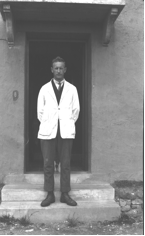Frank Crook was the manager of Barton Farm on the Dartington estate in the 1920s, and oversaw a revolutionary and perhaps controversial milking experiment.
He was the tenant farmer of Barton Farm on the Dartington estate when Leonard and Dorothy Elmhirst arrived in 1925, and at this point he surrendered the tenancy and was compensated for the value of his live and dead stock, standing crops and other miscellaneous items.
In 1926 Crook became Barton Farm’s manager for the new owners, and had a staff of approximately eight.
By the end of 1925 Leonard Elmhirst had drafted a preliminary policy for the agricultural development of the estate. It was later revised and while this did not include Barton Farm, which remained a mixed holding characteristic of South Devon, it was nevertheless managed on sound and scientific lines. The layout of the farm buildings, however, was radically altered.
In 1928 a survey by J R Currie and Long proved that the sale of milk was the most economic undertaking on the farm. Soil and the climate, both favourable to the growth of good and abundant grass and an expanding milk market, both contributed to this conclusion.
Furthermore, in the interests of quality and scientific management, it was decided, despite the opposition of Crook, to have an attested and milk-recorded dairy herd and to sell TT (Tuberculin tested) milk – milk produced by cows that had been certified as free of tuberculosis. In due course, a nucleus of around 30 milking cows with calves-at-foot was assembled mainly by mating the best commercial stock taken over from Crook in 1926 to pedigree South Devon bulls.
The herd average was steadily improved and by the late 1930s had reached approximately 7,500 gallons per recorded cow. Several cows from the herd were also agricultural show prize winners.
Although Barton Farm did not concentrate exclusively on milk production, it did account for more than half its revenue and was sold by retail and wholesale in the Dartington and Totnes area. A flock of 130 ewes also showed a profit and were used to improve the soil and fertility of the pastures after the cattle had grazed them. Straw and other crops played a comparatively small part in the business of the farm.
In 1937, when manager of Old Parsonage Farm C F Nielsen left Dartington, Crook was given responsibility of both Old Parsonage and Barton Farms, becoming Farms Manager in 1938.
Old Parsonage Farm was a new holding farm assembled between 1926-1930 from portions of Shinners Bridge farm, a number of fields originally belonging to Barton farm, land purchased from the Reverend J S Martin, Vicar of Dartington, and a number of surrounding properties at Lownard, Week, Yarner and Dartington Lodge. Crook held this post until his resignation in 1945.
There is an interesting footnote to Crook’s career at Dartington mentioned in a notebook in the Dartington Hall Trust Archive, which describes Leonard Elmhirst’s campaign for election as a county councillor in 1946. The campaign was fought against one Frank Crook.
Dartington would like to thank Kate Caddy for helping compile these biographies.

